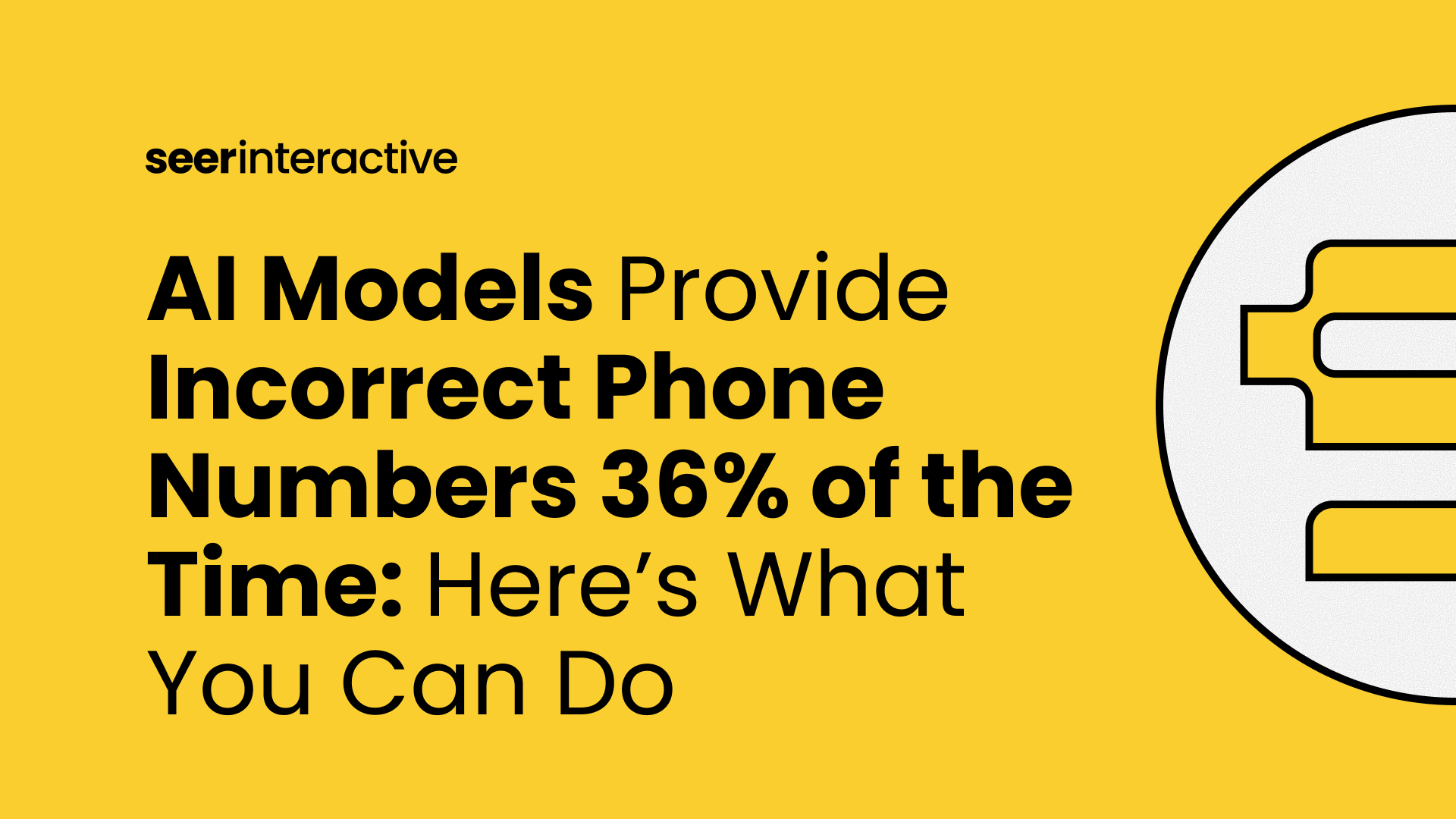Headline Hype
We’ve seen the headlines, we’ve heard that Gen Z is using TikTok a ton more to find things that maybe they would’ve queried on Google for before.
The headlines though make it sound like “TikTok is going to destroy Google”.
Take a look at these:
Is TikTok the new Google? Why TikTok is Gen Z’s favorite search engine by USA Today
Move Over Google. TikTok Is the Go-To Search Engine for Gen Z from AdWeek
TikTok Just Ended Google’s 15-Year Reign as the World’s Most Popular Web Domain on Inc.
ABC News reported that Gen Z is bypassing Google for TikTok as a search engine
And even opinion pieces like this one on The Verge: I tried replacing Google with TikTok, and it worked better than I thought
If you are an exec, it could be easy to think that your multi-million dollar investment in Google might be a bad idea and that search on “search engines” is dying [again].
Practitioners: It’s our time to remind executives that we’ve been here before. Remember when voice search was going to be 50% of all searches by 2020? That died down pretty quickly didn’t it?
That headline diverted tens of thousands of hours of SEOs and content marketers getting run around in circles and being taken away from executing the core parts of SEO. Only to find out that it was a “misunderstanding”.
And yes, some people are now seeking answers on newer platforms that they used to go to Google for. The reality is we do need to be paying attention to this shift.
But don’t start with the apps/platforms. We need to start where we always do: with the audience’s questions and the content that best answers it. In this case, we need to be thinking:
How do we help customers find answers in a world driven by camera-driven vs keyboard-driven content?
Data vs Headline Hype
If a catchy headline has a hypothesis worth exploring, we’re going to look to our own data to validate or invalidate it. Chasing an answer outside your own data is often out of context for your business, hard to be confident in, and therefore bad to make business decisions off of.
We did this back in 2017 when we felt voice search was a headline worth exploring before thinking about assigning resources to the space. We were able to avoid the hype by using the data we had to truly see if our clients were seeing an uptick or not.
Here’s a few ways to avoid hype-driven action and maintain data-driven action.
Avoid hype by considering the data presented
The official data from Google:
“In our studies, something like almost 40% of young people, when they’re looking for a place for lunch, they don’t go to Google Maps or Search,” he continued. “They go to TikTok or Instagram.”
Now take a look back at those headlines in the previous section.
These are BIG headline statements for articles where their only true data point about searching on TikTik is that “40% of young people” data point.
Let’s look at this data point again…
“In our studies, something like almost 40% of young people, when they’re looking for a place for lunch, they don’t go to Google Maps or Search,” he continued. “They go to TikTok or Instagram.”
LUNCH!!!
That data was only for "where to eat" and the 40% was “TikTok and Instagram”.
The original study link is now a 404 (Not Found) Page.
Said that, the insights of Adri are still available interesting… But everything about TikTok as the GenZ search engine is mostly a bluff.
The rest of the data that supports the articles mentioned above come from a handful of user interviews.
Now qualitative data is important – what user’s have to say is a great jumping-off point to validate if that experience is happening at scale within your quantitative data. But it seems to us that these headlines are taking those user stories and attempting to validate them with one very specific data point for one very specific type of search.
That’s not enough data for us to start pushing our client’s budgets from Google to TikTok. Unless of course, our client is in the restaurant industry.
But it is enough data for us to start creating better user hypotheses, asking better questions, and finding data or creating tests to validate/invalidate our ideas.
Keyboard-Generated vs. Camera-Generated Content
If we’re going to challenge ourselves, once again, to avoid hype-driven headline chasing, we need to hypothesize, create tests, and validate/invalidate those tests.
We need data.
Here’s an example of a question these headlines have me asking myself and my team:
What data do we have to better understand where camera-generated content might be a better answer than keyboard-driven content?
Now that’s a question we can explore with data…
Get your data from Google
When we look at what is working on TikTok, clearly that’s going to be camera-generated content, based on the nature of the app.
So how do we understand the places where camera-generated content is going to be preferred over keyboard-generated content?
We’re back to our old friend, Google.
Google spent decades understanding what type of content a user finds most valuable for certain queries. That’s the data we have. Let’s use it.
As search professionals, we have a role in the TikTok conversation that is more than “that was just for lunch, so don’t worry about it,” then calling it a day..
The challenge we have is how to use Google’s understanding of what the right answer is for a query in terms of when camera-generated content is going to be a better answer than keyboard-generated content. Luckily, this is an area where SEO skill sets are well suited.
Here’s one way we’ve been thinking about doing this:
TikTok Index Analysis
Yes, it is about more than TikTok.
But if these are the headlines grabbing your executive’s attention, then guess what – when we use TikTok in our responses we get attention too.
At Seer, we pull all search terms (what the user actually types into Google) with at least one click for all clients from our proprietary Search Discovery product. Then we scrape Google for those search terms to understand the suite of answers they believe are the most helpful for those search terms. So we are not only harvesting where our client ranks, but also Google’s intelligence on what they believe the right answer to be for those search terms.
It’s the perfect data set for us to start exploring camera-driven vs. keyboard-driven content queries.
We’re still in the lab with this, but maybe our TikTok index would look like:
% of client’s queries that have video in the top 3
- What % of the client’s spend is that?
- What is our CPA here vs. avg?
- Etc.
% of client’s queries that have more than 2, 3, 4 videos in the top 10
% of client’s queries that have images in the top 3
The goal once you get this data is to communicate to your executives where you are today.
Then set some baselines with them that make the feel confident you have it under control:
- When this index gets to 5% of our spend or X other metric it’s not longer hype but something we should pay attention to.
- Any month when the % of queries where YouTube is in the top 3 grows by more than X, I want to be alerted.
Why you need to do this on your own data:
We have Client ‘A’ where 68% of all of their spend from last year came on keywords with video in the top 3.
Then we have other clients at 2% of all their spend.
By creating an index across our data warehouse, we scale our smarts out to all our clients.
We’re able to look at each client instantly and see who will be most likely impacted and where we should take action and where action would be a distraction from the most impactful work that could be done for that client.
Be the SEO that follows the customer
Client ‘A’ with 68%: they should be on a fast track to TikTok, IG, Snapchat, and the other camera-driven content apps. That should be your recommendation as a SEO seeing all that spend populating camera-driven content.
Wholesome SEOs may think… but then I’m losing budget!
My response: but you’re gaining C Suite influence.
You’re doing this in a few ways:
- You’re now seen as an unbiased “channel marketer” who will follow the customer wherever they take you
- You are able to help your C Suite determine how much to allocate to testing based on existing data from paid search
- You know the search terms that triggered the video and can help support a successful test
Camera-generated content is about inspiration
Camera-generated content platforms are not really about search and getting a definitive answer. Using what we’ve seen from these platforms, I think Gianluca Fiorelli said it best:
So… it is not really about search, but about inspiration. GenZ is inspired by others about places where to eat on TikTok AND Instagram because of the short videos. Shorts are the real key and the “Revolution” that Google tries to deal with. That’s why it’s pushing them…
Back to the data
Another one we’re still in the lab with, but in theory we could:
- Scrape in all the titles of the camera-driven results for our clients
- Find camera-driven-inspiration content by searching for inspirational words:
- Tips
- How To
- Ideas
- Become
- Near Me
- Develop a % of content, spend, etc that has these keywords in the top 10
Now you have two things that are specific to YOUR data, YOUR industry, YOUR business:
- Queries where your users want to see camera-driven content
- Queries that are about inspiration over just getting a specific, definitive answer
That’s the data you pass over to your social media teams. That’s what the email you write to your C-Suite is backed by when they ask you about these headlines that keep popping up.
Now you, as an SEO, have a role to play in the TikTok conversation with the C Suite
You have a momentum analysis with various hypotheses to know when enough of your queries or your spend is at x for a keyword, you should start to build out content for that keyword on camera-generated content platforms.
In a future post, I’ll drop a few “how-to” videos for y’all to be able to do this with your own data.
We’re Just Getting Started Here
Your Twitter feeds may be continuing down the “SEO is Dead” path, but I believe we’re just getting started. SEOs are primed in 2023 to participate in larger conversations as it relates to helping users find your answer as the best answer.
I plan to drop a piece of content on this topic every 2 to 3 weeks in Q4.
I’ve been thinking about how SEOs are primed to change marketing in 2023. Things like:
- Is SEO’s value really diminishing?
- Camera-driven vs. keyboard-driven content
- Why Google Data is the best way to understand and meet your audience across all your channels (and how to do it)
- How to talk to your C-Suite about SEO in 2023
- Instructionals on getting the data you need to be successful in your role
- And more…



.png)